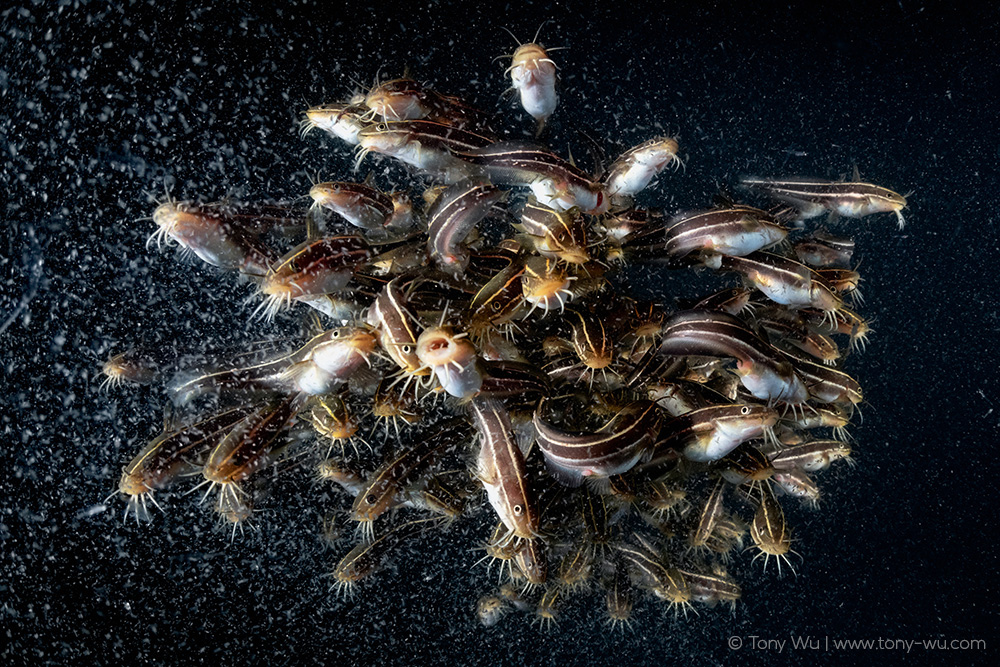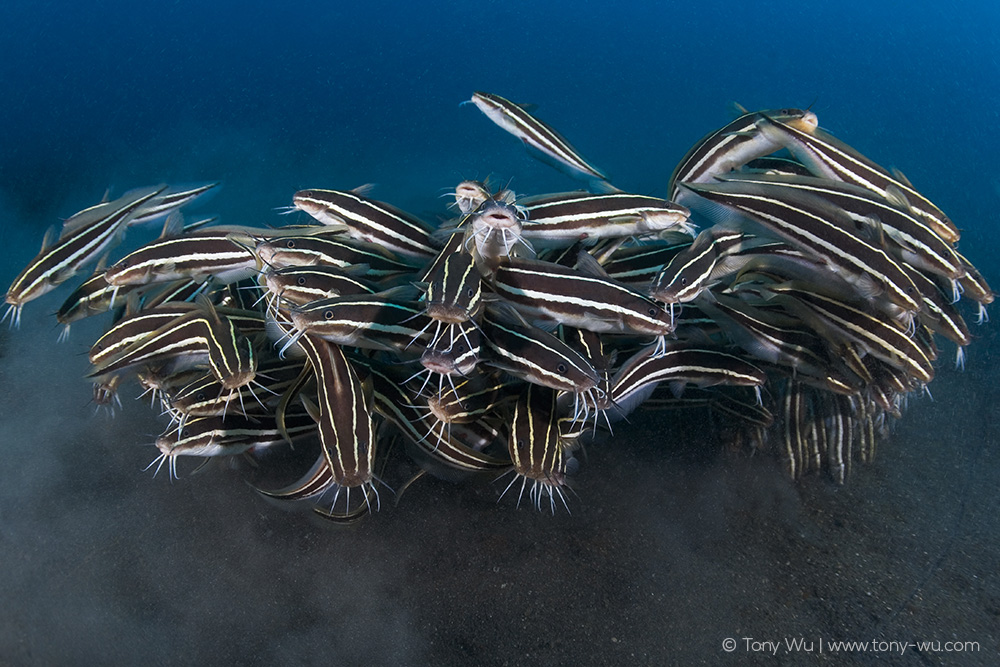Yesterday, I mentioned to a friend my tendency to go down rabbit holes. Figuratively of course.
Meaning that I often get distracted by something that I come across and end up delving into a topic that has no relation to whatever I was doing, finding myself hours later having made zero progress on whatever I was originally engaged in, but in exchange, having learned about something that I hadn't planned to investigate.
That casual comment then caused me to recall the subject of a previous rabbit hole, which led to more digging around, which led to me writing this post—a rabbit hole resulting from a rabbit hole—(RH)^2.
The subject of my mental meandering was Plotosus japonicus, aka Japanese striped eel-catfish, or gonzui ゴンズイ in Japanese, shown here feeding at about 05:00 (I'd been in the water most of the night tracking another species, without success.)

If you're a scuba diver or fish aficionado, you might think—as I did at first—"Oh yeah, striped catfish. I see them everywhere."
I assumed that these were Plotosus lineatus, the striped catfish species most divers are probably accustomed to seeing.
For comparison, this is a photo that I took in Indonesia in 2007 of Plotosus lineatus in a similar foraging situation:

See the difference?
Yeah, neither did I.
A few months ago, I stumbled across an article posted in 2014 titled Japanese Sea catfish uses pH detecting whiskers to hunt. I do not recall what I was doing at the time, but the phrase "Japanese Sea catfish" caught my eye. I'd never come across that wording before, so I thought, "Hmmm, this could be interesting or a total waste of time," which meant—you guessed it—rabbit hole.
The gist of the article and research paper (1) was that Plotosus japonicus catfishes sense minute changes in pH levels caused by respiration of cryptic prey, i.e., animals hidden under the sediment. Polychaete worms (creepy-crawlies) release CO2 when they breathe, inducing brief fluctuations in pH levels. The catfishes' whiskers pick up on this.
Picture retiree beachcombers waving metal detectors across the sand to search for treasure. Replace retirees with whiskered venomous fish and buried treasure with segmented worms. Same, same.
I panicked when I learned that Plotosus japonicus had been described in 2008 (2), because I wasn't aware the Plotosus japonicus existed.
Had I mis-identified the fish in the first photo?
There is overlap in the range of japonicus and lineatus. Moreover, japonicus has since been identified in far away places, like the Red Sea and throughout the Indo-Pacific (3).
Half a day later, I came to the conclusion that while it is nearly impossible to be 100% certain of ID without taking a specimen, the balance of probability was that the fish in the first photo are Plotosus japonicus. Most of the catfishes in Japanese waters seem to be japonicus, not lineatus. Plus, the pH research on japonicus was done with fish in the same area where I took the first photo above.
I realise the japonicus vs lineatus distinction makes no difference in the grand scheme of your life, but the really cool thing—the reason I'm writing this—is because of the pH sensory capability.
It makes sense when you think about it. One can see the parallel to carnivores on land using the sense of smell to find prey.
I wonder how long it will take for polychaete worms to figure out how to hold their breath?
(1) Caprio, John & Shimohara, Mami & Marui, Takayuki & Harada, Shuitsu & Sadao, Kiyohara. (2014). Marine teleost locates live prey through pH sensing. Science (New York, N.Y.). 344. 1154-6. 10.1126/science.1252697. (Link)
(2) Yoshino, Tetsuo, and Hirokazu Kishimoto. "Plotosus japonicus, a new eeltail catfish (Siluriformes: Plotosidae) from Japan." Bull. Natl. Mus. Nat. Ser. A, Suppl 2 (2008): 1-11. (Link)
(3) Goren, M., Stern, N., & Diamant, A. (2020, February 18). New records of Plotosus japonicus in the Red Sea and genetic indications for its presence throughout the Indo-Pacific (Osteichthyes: Plotosidae). Taylor & Francis. https://doi.org/10.6084/m9.figshare.11864988.v1 (Link)